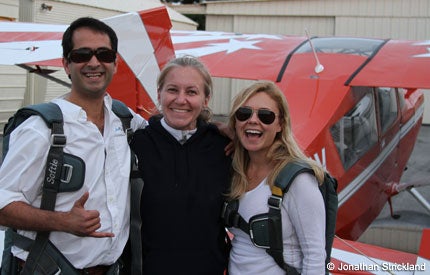 With formation pilot Cyrus Sigari (left) and Super D owner Michelle Kole (right) after a successful air-to-air photo flight. |
Michelle Kole wasn’t sure what kind of airplane she wanted to own. All she knew was that she wanted to own an airplane. As a first-time buyer, she was interested in a variety of types, and it wasn’t until she had an opportunity to fly a Super Decathlon that she knew it was the perfect airplane for her. The two-place rudder-reliant taildragger is great for aerobatics—a passion of Michelle’s—and it’s also a decent cross-country platform for the trips she likes to make. Even so, after bringing the factory-new Super D home, the 34-year-old CFII had moments of being discouraged: “I thought, ’I’m not sure I can fly this airplane.'” Her confidence returned after flying with another instructor, and she realized it was all just part of the buying process. These days, Michelle flies more than ever, feels surer as a pilot, and learns more about her airplane with each flight. In this issue, contributor Marc Lee joins her on a morning flight from the Los Angeles basin to the San Diego area, and talks to her about what she’s learned, and what advice she can offer others about owning an airplane for the first time.
Our second pilot report this month is of another rudder-dominant plane, the Allegro LSA. LSA Editor James Lawrence put the composite high-wing through a series of stalls, Dutch rolls and landings, reporting that it’s a smooth flyer that requires the pilot to be light on the controls. He also takes a look at the composite technology that has become so popular among new airplanes: what is it, why it’s good, and who’s using it.
In the words of one of our previous guest columnists Miles O’Brien: “Flying is the second greatest thrill in life. The first, of course, is landing.” There’s nothing more rewarding, satisfying and yes—ego boosting—than returning an airplane to earth, safely and smoothly. Back when I took my first few flight lessons, all I wanted to do was practice landings. If I could land a plane, I could fly, right? Each lesson was an argument (that I never won) with my CFI who, of course, insisted on slow flight and stalls first. Even pilots who have logged thousands and thousands of hours still brag about a good landing. And as we all know, a good landing starts with a good approach. In this issue, contributor Budd Davisson offers techniques to elevate your status from “pilot” to “aviator” by improving your landings.
Someone most certainly deserving of aviator status is this month’s guest speaker, Nancy Miller Stratford. During World War II, she served as a ferry pilot for Britain’s Air Transport Auxiliary, having flown as pilot in command in 50 different aircraft types, including fighters, bombers and transports. Of those, 41 were flown solo for her first flight, with only the help of “some notes” from the ATA. Today, at age 91, Nancy shares with us her experiences in the air during World War II, and reflects on what flying has meant to her over the years.
Also in this issue, we take a look at career options for professional pilots, and for those who want to work within aviation but not necessarily fly. Contributor John Ruley
gives a rundown of 10 jobs on the ground, from cutting-edge technologies of remotely piloted aircraft and space operations, to ATC and dispatch. Marc Lee analyzes the outlook for professional pilots. An upcoming shortage that’s expected to be huge and is already showing signs of life will lead to unmet demand and tremendous opportunity for those who are prepared and driven.
In an online Plane & Pilot reader survey, 47% of respondents said they had never flown a helicopter but would like to. In this issue, Senior Editor Bill Cox, who earned his helicopter rating 23 years ago in a Robinson R22, returns to the Robinson Helicopter factory in Torrance, Calif. Bill talks with Kurt Robinson, who has recently taken over leadership of the company from his father Frank, and flies the new turbine-powered R66. To participate in our ongoing surveys and be included in upcoming issues, visit www.planeandpilotmag.com, and you’ll find them down the page on the right.
There’s now an additional way to read Plane & Pilot! We’ve launched a new digital edition of the magazine, available on your computer, iPhone, iPad, Android or other mobile device through Zinio. Sign up at www.zinio.com/planeandpilot to take each issue on the go.



